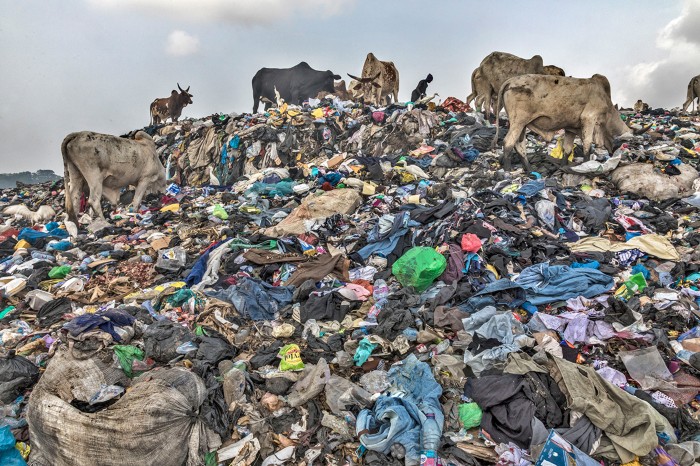From Nature

A rubbish heap in Accra, Ghana, containing discarded second-hand clothing imported from Europe and the United States. Credit: Andrew Esiebo/Panos Pictures
More than a decade ago, scientists defined a set of biophysical global limits, known as planetary boundaries, within which humanity can operate ‘safely’. These span nine areas — climate change, the biosphere, nutrients, water, land use, ocean acidification, ozone depletion, aerosols and ‘novel entities’ (pollutants and pathogens)1. Since 2019, a task force called the Earth Commission, co-led by one of us (J.R.), has been integrating social-science perspectives to ensure that such quantified boundaries are ‘just’ as well as safe2.
Next year, this global team of natural and social scientists (including many of us) will issue its first report outlining these ‘Earth system boundaries’ (ESBs). Addressing regional as well as global scales, these limits are based on the latest science, modelling and literature assessments. Accounting for impacts on communities means that the boundaries will be tighter. For example, climate change is already harming the health, property and livelihoods of hundreds of millions of people each year, and that is before the world reaches the Paris agreement cap of 1.5–2 °C of global warming.
Researchers must develop methods to identify what cities and companies must do for the world to stay within the ESBs. The approaches will help them to assess their share of the responsibility for staying within global budgets of carbon, water, nutrients, land and other natural resources, and set targets to protect them. This will be difficult. For example, how much of the world’s phosphorus fertilizer should well-off London or struggling Dhaka rightfully access to produce food for their residents3? How should responsibility for protecting the Amazon rainforest be apportioned among hundreds of distant cities and companies that source supplies from the region or benefit from its ecosystem services4?
Science-based targets are crucial (see ‘Targeted ambitions’). Objectives must be measurable, actionable and time-bound5. They must be dynamic and adjusted in the face of new evidence. And they should be fair, reflecting degrees of responsibility and ability to mitigate harms. Those with the most capacity or that cause the most damage should do more to help those in need to survive and thrive.
Sources: SBTi Progress Report 2021 (https://go.nature.com/3AWUUKG)/CDP 2021 Annual Questionnaire — Investor and Supply Chain Version/M. Meinshausen et al. Data set at Zenodo (https://doi.org/jbp9; 2021)/ M. Pathak et al. In Climate Change 2022: Mitigation of Climate Change (eds P. R. Shukla et al.) (Cambridge Univ. Press, 2022).
Yet few cities and companies currently have such targets. For climate, for example, according to corporate data from Bloomberg Terminal, only 22 of the 500 top greenhouse-gas-emitting companies set targets in line with the Science-Based Targets initiative (SBTi; a collaboration of more than 1,000 companies and sustainability bodies). Some (137) follow other schemes; the majority have set no targets. Similarly, when we looked at the top 200 cities with the highest emissions (linked to consumption, including energy, food and goods), only 110 had ‘net-zero’ pledges that align with the Paris agreement6. Numbers are lower or missing for biodiversity and other ESBs.
Scientists have three key roles — to develop methods, to make the processes and assumptions involved transparent, and to explore ways to hasten the adoption of science-based target setting. Ultimately, it will fall to national governments and international bodies such as the United Nations to implement legislation and mechanisms for cities, companies and others to adopt these targets.
Seven gaps
Here we highlight seven knowledge gaps in translating ESBs for cities and businesses.
Develop common procedures. Many steps and choices are involved in translating targets. Principles and protocols must be developed, and methods, metrics, assumptions and uncertainties must be clear. Without clarity, some cities and companies will seek to minimize their own responsibility and maximize the resources that they claim; powerful actors might exert undue influence.
The first stage is to transcribe parameters of the Earth system, such as global temperatures or levels of ocean acidification, into quantities related to human actions. Targets can then be set against these, such as emissions or areas of deforestation. Many human actions and natural processes can influence each parameter. Links can be difficult to quantify, especially at regional scales.
A woman in Hong Kong pushes waste cardboard to a recycling depot.Credit: Anthony Wallace/AFP via Getty
Next, these anthropogenic pressures need to be attributed to cities and companies. This is complicated by long and complex supply chains. For example, determining the water footprint of a car manufacturer might require data on the production of 30,000 vehicle parts. For cities, evaluations of consumption footprints and impacts need to take into account where goods are produced, how they are made and from what.
Principles for sharing resources and responsibility must also be decided. Initial allocations might need adjusting to reflect socio-economic status or access to resources.
Focus on interactions. Earth system boundaries are linked, so targets need to be aligned. Climate change, for instance, depends on land-based processes — such as methane emissions from thawing permafrost, and weakened carbon sinks through deforestation. Several pressure points can combine so that tipping points are reached sooner7,8. For example, climate-driven wildfires in the Amazon basin compound tree loss from farming. Events in one place can have consequences locally, far away or globally. Cutting down too many trees in the Amazon basin would reduce rainfall and alter river flows and water volumes across Brazil and beyond. And measures that focus on one domain can be beneficial or detrimental to others. Boosting fossil-fuel production to offset lost supplies from Russia, for instance, will further stress the climate system and could lead to more insecurity for food and water in the long run.
Cities exchange people, energy and goods with their local and global hinterlands9,10. Companies work with others across their value chains, near and far. Both interact with each other. We found that the top 200 cities with the largest greenhouse-gas emissions host the headquarters of 360 of the top 500 emitting companies. More than 50% of these cities and companies are in water-stressed areas, including Mexico City, Santiago, Beijing, Madrid, New Delhi, Rome, Istanbul in Turkey and Phoenix, Arizona.
Researchers should identify key activities that span several ESBs, and evaluate what can be achieved by targeting them. For example, palm oil is widely used for food, detergents and cosmetics. A company that buys much of its supply from Borneo would need to account for land-use change, loss of biodiversity and climate change, regionally and globally, in its corporate sustainability reporting and target setting11. If such imports are reduced, the net effect would depend on which substitutes are chosen and where they are sourced from. For example, rapeseed oil might come instead from deforested parts of Malaysia.
Spatial impacts of cities and companies on other places and suppliers need to be quantified. For example, 30% of biodiversity loss is linked to global trade, according to one analysis that connected 25,000 species threats to 5 billion supply chains and consumption of commodities such as coffee, tea, sugar, textiles and fish12. In the meantime, we recommend that companies’ sustainability reports include their impacts on key urban and other hotspots, such as the Amazon and Arctic.
Residents of Manila set up a community farm on waste city ground to secure food supplies.Credit: Ezra Acayan/Getty
Acknowledge dynamics. Many targets focus on a particular date, such as 2030 or 2050. But pathways are important. For example, reducing carbon emissions linearly to net zero by 2050 would result in less warming than keeping them high for the next decade and then suddenly reducing them. Acceptable limits might change as we learn more. For example, if better modelling and observation reveal that ice sheets in Greenland will melt faster than expected, climate limits would need to be tightened13.
Researchers must factor in how changing social contexts influence impacts and vulnerabilities, including growing populations, more middle-class consumers, increasing inequality, concentrations of wealth and geopolitical tensions. For example, if resources are shared equally across every person globally, Lagos’s share should grow if its population quadruples by 2100, as estimated. But if the global population also rises, that share would be proportionately less. Alternatively, cuts in fertilizer supply owing to Russia’s invasion of Ukraine might shift where the world sources its food, altering targets that way.
Message to mayors: cities need nature
Changes in the size and number of cities, as well as companies emerging, growing, merging and closing, need to be considered. For example, rapid urbanization threatens biodiversity in 93% of the top 200 priority ecoregions for conservation14.
Although it is practically impossible to account for all these changes, precautionary approaches can be taken. ESBs can be set more stringently or translated to contain buffers — allocating 80% of available resources, say — to leave room for emerging users and failures. Empirical evidence is needed to determine reasonable buffers.
In reality, some targets will be missed, whereas others might be achieved ahead of time. Researchers must develop an agile approach — one that uses time-sensitive and dynamic goal setting with regular checks, adjustments and updates. For example, the Glasgow Climate Pact, adopted by 197 nations at the COP26 climate conference in November 2021, stipulates that signatories of the Paris climate accord update national mitigation ambitions annually. Local shares and targets could be added.
Allocate for justice and equity. Various principles for sharing resources and responsibilities — such as distributing equal shares per capita or considering capacity, the right to development and historical responsibility — reflect different value judgements and have different limitations. Targets need to reflect socio-economic contexts, such as income and consumption levels, environmental impacts or capabilities to act. For example, cities with high consumption, historical emissions or revenues should arguably adopt more stringent targets than others.
Solar-powered electric taxis in Jacqueville, Cote d’Ivoire.Credit: Sia Kambou/AFP via Getty
For cities, this also means taking into account resources and environmental endowments, and ensuring minimum levels of access to energy, food and water for all. For example, using available data on the domestic water footprint per person15, we found that 14 of the most populated 100 urban areas, including Dhaka, Karachi, Lagos, Kinshasa and Addis Ababa, cannot provide even the basic requirement of 100 litres of clean water per capita per day for drinking, cooking and hygiene. Such cities should be given priority access to regional water supplies. For companies, their economic value, differences in capacity and social roles need to be considered. For example, in environmental-impact assessments by the US ice-cream maker Ben & Jerry’s, German sportswear manufacturer Puma and US dairy marketing cooperative Cabot Creamery, the number of employees, or economic value added, were taken into account when apportioning responsibility towards a global carbon budget, regional water resources and so on.
Such adjustments are contentious because perceptions of fairness differ. Scholars must reveal the hidden assumptions and value judgements behind each sharing principle, and evaluate them according to internationally accepted principles of justice, such as intergenerational and intragenerational justice. Outcomes and implications for different socio-economic groups must be assessed.
Support monitoring and accountability. Companies and cities use a variety of platforms and standards for target-setting16. Most do not disclose progress. Companies and cities can choose to track carbon emissions and data on forest and water security through a global disclosure system managed by CDP, a non-profit organization in London.
Much work needs to be done to support monitoring and accountability. We recommend that initiatives, such as the International Sustainability Standards Board, engage with cross-disciplinary scientists to ensure that its proposed ‘global baseline of sustainability-related disclosure standards’ explicitly links cities and companies with ESBs. Independent auditing systems are also needed.
Establish governance mechanisms. Globally, policies and regulations will be needed to incentivize or mandate cities and companies to adopt targets. This is daunting. Beyond climate change and the biosphere, there are no established governance systems to operationalize ESBs. Global targets such as the UN Sustainable Development Goals are often not legally binding. Cities and companies set targets voluntarily.
One approach is to recognize each of the ESB domains as a global commons. As it already does for climate change, the UN could initiate intergovernmental panels and call on governments to mandate science-based target setting for large cities and companies. There is no guarantee this would fix the problem, as demonstrated by the painfully slow progress on climate change. But it will put ESBs on the policy agenda. Public pressure would help, if people are made aware of ESBs.
Synergies between geographical concentrations of cities and companies should be exploited. This requires bringing together urban and corporate regulations and targets, which are currently considered separately. They operate under different legislations and report to different bodies.
The Global Commons Alliance, which the Earth Commission is part of, is making progress. For example, the Science Based Targets Network is developing methodologies for target-setting for companies and cities for climate and other pressures. The World Economic Forum is well positioned to champion and coordinate actions by cities and companies. For example, it could bring on board organizations such as ICLEI — Local Governments for Sustainability, the C40 Cities network of mayors, the Global Covenant of Mayors for Climate & Energy, the World Business Council for Sustainable Development and the We Mean Business Coalition. Scientific organizations should provide input and act as neutral brokers.
There will be resistance. As with climate and other sustainability measures, strong legislation along with the threat of lawsuits (as happened in the 2021 climate-change case against Royal Dutch Shell in the Netherlands) and reputational pressure might be needed to bring cities and companies on side, by affecting access to investment, revenues and consumer demand.
Design incentives. Widespread adoption of science-based target setting by cities and companies — and getting them to work together — is essential, and might prompt national governments to follow. For example, the government of Japan adopted net-zero targets after most of its major cities made such pledges.
Quality trademarks for products and services, such as kitemarks, could be issued to raise awareness. For example, the European Commission’s Mission Platform for Climate-Neutral and Smart Cities supports more than 100 cities, from Paris to Istanbul, to become climate-neutral by 2030. They receive a ‘mission label’ and the commission’s support on technical, capacity-building and financial aspects. Similarly, UN organizations could highlight and support ESB early adopters and high-fliers.
Financial incentives should be expanded. Rabobank in the Netherlands rewards high-performing dairy farmers in biodiversity conservation with better credit rates. French banking group BNP Paribas offers loans to companies or projects that demonstrate positive and measurable social or environmental impacts.
It will be a long haul, but humanity needs to stay within the planet’s finite budgets. Developing scientifically robust and socially just ways to allocate resources and responsibilities is essential if Earth’s boundaries are to be respected.
Nature 609, 463-466 (2022)
doi: https://doi.org/10.1038/d41586-022-02894-3
References
-
Rockström, J. et al. Nature 461, 472–475 (2009).
-
Rockström, J. et al. Earth’s Future 9, e2020EF001866 (2021).
-
Lucas, P. L., Wilting, H. C., Hof, A. F. & van Vuuren, D. P. Glob. Environ. Change 60, 102017 (2020).
-
Obura, D. O. et al. Science 373, 746–748 (2021).
-
Andersen, I. et al. Natl Sci. Rev. 8, nwaa186 (2021).
-
Kılkış, Ş. Renew. Sust. Energy Rev. 167, 112733 (2022).
-
Lade, S. J. et al. Nature Sustain. 3, 119–128 (2020).
-
Lenton, T. et al. Nature 575, 592–595 (2019).
-
Bai, X. et al. Annu. Rev. Environ. Res. 42, 215–240 (2017).
-
Liu, J. et al. Curr. Opin. Environ. Sustain. 33, 58–69 (2018).
-
Whiteman, G., Walker, B. & Perego, P. J. Mgmt Stud. 50, 307–336 (2013).
-
Lenzen, M. et al. Nature 486, 109–112 (2012).
-
Boers, N. & Rypdal, M. Proc. Natl Acad. Sci. USA 118, e2024192118 (2021).
-
Li, G. et al. Nature Commun. 13, 1628 (2022).
-
Hoekstra, A. Y. & Mekonnen, M. M. Proc. Natl Acad. Sci. USA 109, 3232–3237 (2012).
-
Bjørn, A., Tilsted, J. P., Addas, A. & Lloyd, S. M. Curr. Clim. Change Rep. 8, 53–69 (2022).








